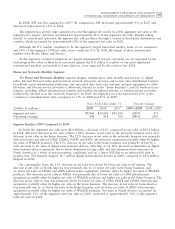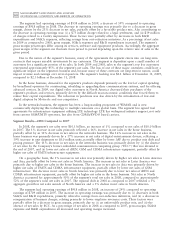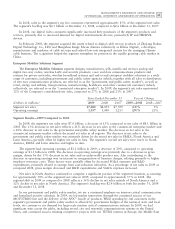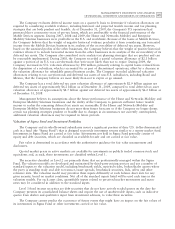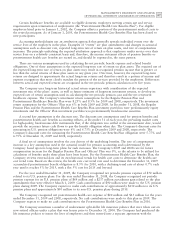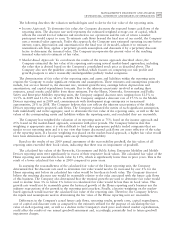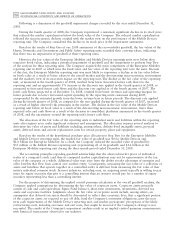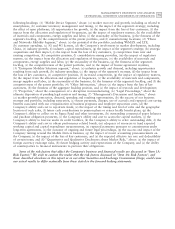Motorola 2009 Annual Report Download - page 77
Download and view the complete annual report
Please find page 77 of the 2009 Motorola annual report below. You can navigate through the pages in the report by either clicking on the pages listed below, or by using the keyword search tool below to find specific information within the annual report.
69
MANAGEMENT’S DISCUSSION AND ANALYSIS
OF FINANCIAL CONDITION AND RESULTS OF OPERATIONS
The following describes the valuation methodologies used to derive the fair value of the reporting units.
•Income Approach: To determine fair value, the Company discounts the expected future cash flows of the
reporting units. The discount rate used represents the estimated weighted average cost of capital, which
reflects the overall level of inherent risk involved in our operations and the rate of return a market
participant would expect to earn. To estimate cash flows beyond the final year of our model, the Company
uses a terminal value approach. Under this approach, the Company uses estimated operating income before
interest, taxes, depreciation and amortization in the final year of its model, adjusts it to estimate a
normalized cash flow, applies a perpetuity growth assumption and discounts it by a perpetuity discount
factor to determine the terminal value. The Company incorporates the present value of the resulting
terminal value into its estimate of fair value.
•Market-Based Approach: To corroborate the results of the income approach described above, the
Company estimated the fair value of its reporting units using several market-based approaches, including
the value that is derived based on the Company’s consolidated stock price as described above. The
Company also uses the guideline company method, which focuses on comparing our risk profile and
growth prospects to select reasonably similar/guideline publicly traded companies.
The determination of fair value of the reporting units and assets and liabilities within the reporting units
requires the Company to make significant estimates and assumptions. These estimates and assumptions primarily
include, but are not limited to, the discount rate, terminal growth rates, earnings before depreciation and
amortization, and capital expenditures forecasts. Due to the inherent uncertainty involved in making these
estimates, actual results could differ from those estimates. For the Home, Networks, Government and Public
Safety and Enterprise Mobility reporting units, the Company assigned discount rates ranging from 12.5% to
13.5% in 2009 and 13.0% to 14.0% in 2008. The Company assigned a discount rate of 17.5% to the Mobile
Devices reporting unit in 2009 and, commensurate with development stage enterprises or turnaround
opportunities, 25% in 2008. The Company believes this rate reflects the inherent uncertainties of the Mobile
Devices reporting unit’s projected cash flows. The Company evaluated the merits of each significant assumption,
both individually and in the aggregate, used to determine the fair value of the reporting units, as well as the fair
values of the corresponding assets and liabilities within the reporting units, and concluded they are reasonable.
The Company has weighted the valuation of its reporting units at 75% based on the income approach and
25% based on the market-based approach, consistent with prior periods. The Company believes that this
weighting is appropriate since it is often difficult to find other appropriate publicly traded companies that are
similar to our reporting units and it is our view that future discounted cash flows are more reflective of the value
of the reporting units. If a heavier weighting was placed on the market-based approach, a higher fair value would
have been determined for all reporting units except Enterprise Mobility.
Based on the results of our 2009 annual assessment of the recoverability goodwill, the fair values of all
reporting units exceeded their book values, indicating that there was no impairment of goodwill.
The calculated fair values of the Networks, Government and Public Safety, Enterprise Mobility and Mobile
Devices reporting units were significantly in excess of their respective book values. The calculated fair value of the
Home reporting unit exceeded its book value by 10%, which is significantly lower than in prior years. This is the
result of a lower calculated fair value in 2009 compared to prior years.
In assessing the reasonableness of the calculated fair value of the Home reporting unit, the Company
determined that the discount rate used to determine fair value would need to be increased by over 2% for the
Home reporting unit before its calculated fair value would be less than its book value. The Company does not
believe the resulting discount rate would be reasonable relative to the risks associated with the future cash flows
of this business. The Company also determined that the terminal growth rate used to determine fair value would
need to decline from 3% to below 1% before its calculated fair value would be less than its book value. This
growth rate would not be reasonable given the historical growth of the Home reporting unit’s business nor the
industry expectations of the growth in the reporting unit’s markets. Finally, a heavier weighting on the market-
based approach would increase the calculated fair value of the reporting unit. Therefore, the Company believes
the inputs and assumptions used in determining the fair value of the Home reporting unit are reasonable.
Differences in the Company’s actual future cash flows, operating results, growth rates, capital expenditures,
cost of capital and discount rates as compared to the estimates utilized for the purpose of calculating the fair
value of each reporting unit, as well as a decline in the Company’s stock price and related market capitalization,
could affect the results of our annual goodwill assessment and, accordingly, potentially lead to future goodwill
impairment charges.


